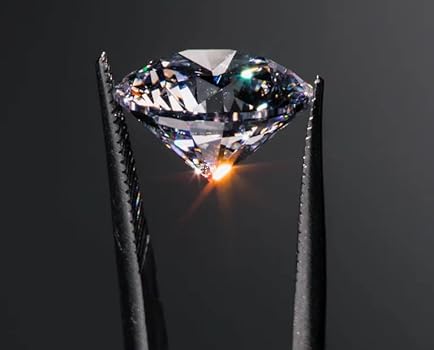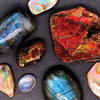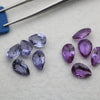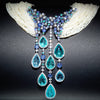Diamonds and Their Doubles: The Quest to Replicate Brilliance
- by Greta Fontanella

For centuries, diamonds have symbolized love, commitment, and luxury. Their unmatched hardness, fire, and brilliance made them the ultimate gemstone—coveted by royalty, collectors, and couples alike. Diamonds are formed under intense heat and pressure deep within the Earth’s mantle, typically over a billion years. They’re composed of pure carbon, crystallized into the hardest known natural material. This durability, combined with their optical properties—especially their ability to reflect and refract light—gives them their signature sparkle known as "fire."
How Diamonds Are Graded: The 4 Cs
Diamonds are evaluated using the 4 Cs: Carat, Cut, Clarity, and Color:
-
Carat measures weight—not size. A 1-carat diamond equals 200 milligrams.
-
Cut impacts brilliance. Excellent and Ideal cuts maximize sparkle.
-
Clarity accounts for inclusions and blemishes. Grades range from Flawless (FL) to Included (I).
-
Color refers to the body color of white diamonds. The best are graded D (colorless) through Z (light yellow).
Fancy colored diamonds (like pink, blue, or yellow) are graded differently and often valued for rarity over clarity.
Cubic Zirconia: The First Imposter
Introduced in the late 1970s, cubic zirconia (CZ) became the go-to affordable diamond lookalike. It’s entirely synthetic, inexpensive, and has high clarity. CZ scores about 8–8.5 on the Mohs hardness scale, making it far softer than diamonds. While initially brilliant, CZ tends to cloud or scratch with daily wear, and it lacks the refractive sharpness of diamond. Nonetheless, it revolutionized fashion jewelry, offering glamour without the cost.
Zircon: Often Confused, Rarely Understood
Zircon is a natural gemstone that occurs in a wide range of colors, including blue, yellow, and colorless. It has been used in jewelry since ancient times and has significant brilliance due to its high refractive index. However, its similarity in name to cubic zirconia has unfortunately led to confusion and underappreciation. Zircon is softer (6.5–7.5 on Mohs), making it better suited for pendants and earrings than rings.
Moissanite: The Sparkling Challenger
Moissanite was originally discovered in a meteor crater by Henri Moissan in 1893. Today, it’s lab-created and valued for its intense fire and brilliance, which even exceed those of a diamond. Moissanite is very hard (9.25 on Mohs) and durable, making it suitable for daily wear. Its higher dispersion gives it a more rainbow-like sparkle, which is loved by many and considered “too flashy” by others. Importantly, moissanite is significantly less expensive than natural or lab-grown diamonds.
Lab-Grown Diamonds: A Modern Breakthrough
Lab-grown diamonds are created through two methods:
-
HPHT (High Pressure High Temperature): Mimics natural formation conditions.
-
CVD (Chemical Vapor Deposition): Grows diamond crystals from a hydrocarbon gas mixture.
Both methods produce real diamonds—identical in chemical composition and appearance to mined diamonds. Lab-grown diamonds are often 30–40% less expensive and come free of the ethical and environmental issues associated with some mined stones. They can still be certified by GIA, IGI, or other reputable labs.
Market Impact: The Democratization of Sparkle
The rise of diamond simulants and lab-grown alternatives has dramatically changed consumer expectations. Couples increasingly choose lab-grown diamonds for engagement rings due to ethical sourcing, larger sizes for the price, and environmental considerations. Jewelers must now educate customers more thoroughly to distinguish between synthetic, simulant, and natural stones.
Why We Keep Imitating Diamonds
Throughout history, diamonds have symbolized power, permanence, and prestige. Their unmatched optical properties and cultural status drive a desire to imitate their appearance, whether for accessibility or ethical reasons. From Victorian paste gems to today's lab innovations, the pursuit of brilliance never stopped.
Choosing What’s Right for You
-
Natural Diamonds: For tradition, prestige, long-term value
-
Lab-Grown Diamonds: For ethical, budget-conscious, modern buyers
-
Moissanite: For maximum sparkle and durability at a fraction of the cost
-
Cubic Zirconia: For budget-friendly fashion and short-term wear
-
Zircon: For those who want a natural, brilliant alternative with unique charm
Whether you choose a diamond or one of its doubles, each stone offers a unique story of science, craftsmanship, and values. What matters most is that it reflects your personal style and priorities—because the best stone is the one that speaks to you.
- Posted in:
- cubic zirconia vs diamond
- diamond alternatives
- diamond simulants
- diamond vs moissanite
- ethical diamonds
- gemstone comparison
- HPHT vs CVD diamonds
- lab-created diamonds
- lab-grown diamonds
- moissanite engagement rings
- sustainable jewelry
- zircon gemstone





